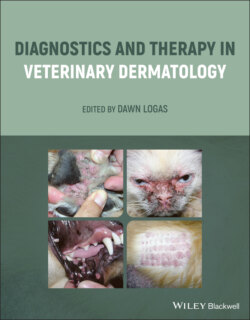Читать книгу Diagnostics and Therapy in Veterinary Dermatology - Группа авторов - Страница 41
Lesion Distribution
ОглавлениеIn addition to lesion type, distribution on the patient’s body contributes to differential diagnosis list formation. For example, pustules and crusts present on the face, ears, and limbs of a dog are suggestive of pemphigus foliaceus. Erosions, ulcerations and draining tracts in the inguinal region of an overweight cat suggest infection with rapid‐growing mycobacteria (Figure 2.7). Feline mosquito bite hypersensitivity is characterized by papules, plaques, and crusts on the bridge of the nose, pinnae, and paw pads. Perianal erythema can be a sign of food allergy (Figure 2.8).
In addition to anatomic location, lesion distribution on different colors of the coat or skin can be important. These changes are often more subtle and can take practice to recognize. In cases of solar dermatitis, affected areas of white skin will be thickened, erythematous, and even infected, while adjacent pigmented skin will be normal (Figure 2.9). In cases of black hair follicular dysplasia, diffuse alopecia and broken hairs will be seen in black‐haired areas, while white‐haired areas will be normal.
Figure 2.7 Ulcerations, draining tracts, and scarring in the inguinal region of a cat with rapid‐growing mycobacteria.
Figure 2.8 Perianal erythema in a dog with food allergy.
